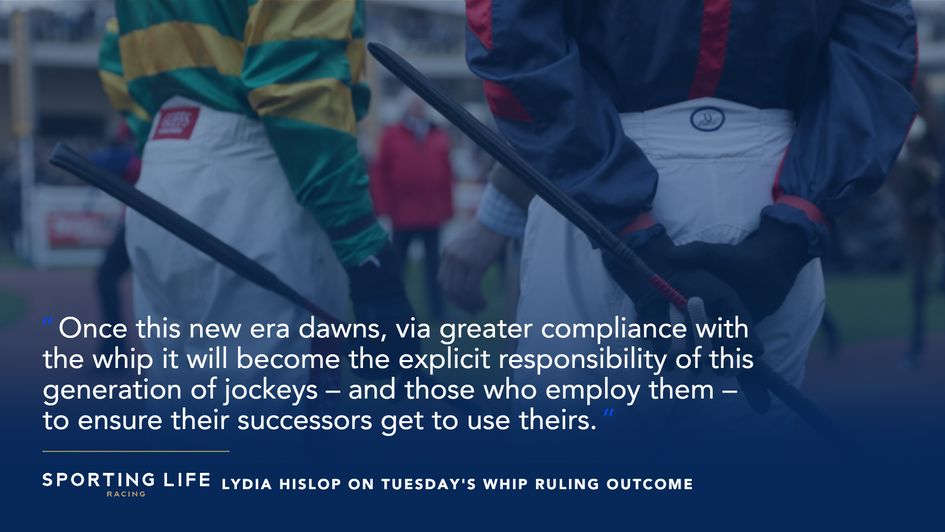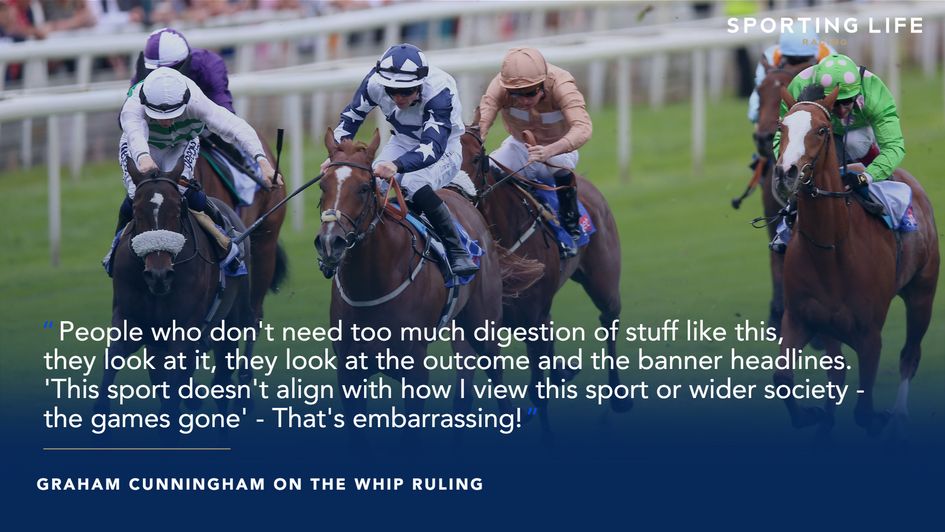Our columnist is back with her thoughts on the forthcoming new whip regulations and the challenges they pose.
It would be an unfair, or partisan, critic who reads the Whip Consultation report and concludes its contents are not the fruits of many months’ hard toil, and that the way forward was easy. But this won’t be the last word on the whip.
The document itself explicitly concedes that any future adverse scientific analysis – and implicitly the further evolution of public opinion – would likely kick-start a repeat process. In the meantime, how quickly revision comes about will be, from an as-yet-unspecified date, literally in the hands of this generation of jockeys. Yet it’s not just them who now have less room to manoeuvre.
“This was a very thorough process, conducted by a group of people containing broad experience and significant expertise in a number of key areas,” says the British Horseracing Authority. “The quality and depth of thought that has gone into this would be difficult to replicate and, as such, we encourage people to recognise this, and to give these changes an opportunity to be implemented and tested.”

Yet within hours of publication, Roly Owers of World Horse Welfare – himself a member of the 15-strong Consultation steering group – asserted that the recommendations “do not go far enough”.
“We are clear that we want to see a move away from the use of the whip for ‘encouragement’ in horseracing, on both welfare and ethical grounds,” the equine charity’s chief executive stated. “We simply do not believe its use is justified, especially in light of what we now know about what makes a good horse-human partnership.”
Many within the racing industry, and its most uncompromising adherents, dismiss such views as crank but this is a mainstream charity and its leader highly esteemed across equestrian sport. The RSPCA went further, describing the review as “an extreme disappointment and a real missed opportunity for horse welfare”, adding that “there will be complete disbelief from countless animal lovers by this news”.
Yet only 2,147 people responded to the BHA’s well-publicised call for evidence, of which only 510 were members of the public with no connection to, or particular love for, racing. The only surprise was merely 86 per cent of them thought the whip should not even be carried (albeit, oddly, that number receded to 78 per cent who said it should not be used for encouragement).
These numbers to some extent lay bare the sport’s perpetual dilemma over whether it is precipitating its own bowdlerisation by engaging with a vocal minority, who have an easy sell to a world that pauses to listen long enough to hit the vote button. The steering group, primarily comprising industry people but also containing clear dissenting voices, nonetheless opted to proceed on matters of principle.
Your sympathy with the findings, or indeed existence, of this consultation therefore probably aligns with the degree to which you accept the legitimacy of the ‘social licence’ concept. For those who don’t recognise this premise, I’d advise a brief glance around at the lives you lead and what is accepted by the majority of the public now compared with ten or twenty years ago. The use of animals in sport is not immune from this dynamic.
Graham Cunningham: An offer racing couldn't refuse
Henderson backs jockeys to adapt
Perhaps you accept the proposition but argue the public’s attitude towards the whip is based on a lack of understanding of its construction, deployment, and the rules that police it. Opposition, you may argue, is based on perception rather than whether the whip is in fact detrimental to the welfare of a horse.
The report has some sympathy for this view, citing a recent survey by public-opinion specialist Ipsos UK in April that showed 55 per cent of 1,119 British adults questioned “supported a ban on use of the whip”, but that figure dropped by 12 per cent when further explanation of its design and application was provided. However, younger people were more likely to prefer its withdrawal.
This indicates British racing has done a bad job, in a difficult landscape, of communicating about a fundamental tool for maximising equine athletic competitiveness. Make no mistake – the whip does that. If you doubt it, take a look at racing in Sweden or Norway currently, where at a minimum the whip can no longer be used for encouragement. It’s a strangely anaemic affair, in which horses race baggily across the width of the track and the least distracted one wins.
As competition is the essence of elite sport, it’s impossible to imagine British racing preserving its existing hold on fans if it follows Scandinavia, whose racing is of a lesser global standard.
Of course, prioritising competition wouldn’t be a justification for this tool if it causes harm, yet it’s also clear the sport has failed to heed past directives to support further scientific investigation into the effects of the whip. Existing analysis is currently “inconclusive” according to the group, which logically complicated their course of action.
This report requires both shortcomings to be addressed, although its stated support for Dr Madeleine Campbell’s ethical framework project at the Royal Veterinary College may presage the future. The cross-industry Horse Welfare Board’s A Life Well Lived document of 2019 cited Campbell’s argument that “in racing generally, the benefits to horses outweigh the harms” but “she does not believe this applies in relation to the use of the whip for encouragement”.
Perhaps the most unanticipated of its recommendations will provide practical help on the perception issue? The whip will now only be permitted in the backhand grip. A single forehand strike (except for safety purposes) will likely trigger a seven-day sanction, and multiple uses perhaps even disqualification – subject to the technical phase of implementation.
Owers was patently among those who, the group’s report acknowledges, “retained a preference for removal of the whip for encouragement”. However, those members nonetheless agreed “to move forward with the process and make improvements”. Advancement, the document implies, was achieved via consensus rather than blunt compromise between any points on which the group was polarised.
A reduction in the permitted maximum number of strikes – seven on the Flat and eight over Jumps – was rejected in favour of outlawing the forehand. Backhand usage discourages a wide or high downstroke, resulting in a shorter action that – the report argues – greatly reduces the likelihood of the whip being used with excessive force. Jockey and group member PJ McDonald has since suggested it also limits the risk of the whip landing on a horse’s more sensitive abdomen rather than its muscled hind quarters.
So, according to the group – which also contained fellow jockey Tom Scudamore, and referred to Frankie Dettori, Richard Johnson and Harry Skelton for further technical expertise – races should not only look more palatable for those made uncomfortable by the sight of a manifestly raised whip, but also in actuality promote a consistently better experience for the horse.
Cue those insisting the foam-padded, energy-absorbing whip is specifically designed not to hurt a horse, and therefore any change unnecessarily panders to the animal-rights lobby. Yet this is not irrefutably true. BHA analysis shows that last year one horse was wealed via use of the whip, and not hurting an animal you’re seeking to encourage is the lowest of bars.
Change has in the past brought about advancement in some senses. The reduction of the strike limit via the previous Whip Review in 2011 vastly improved the standard of whip usage across the jockey population whilst having no discernibly detrimental effect on the sport’s competitiveness.
It’s a blunt rule, admittedly, because one strike can be too many in certain instances and nine sometimes perceived as no impost to a responding horse. Nonetheless, inappropriate use of the whip makes a horse more likely to lose than to win via shifting from a true line, and to generate interference rather than avert it. The strike limit has undoubtedly promoted more thoughtful usage.
However, it has also read to the outside world as a tacit admission of the potential for harm – even though some form of limit had long existed inside the stewards’ room for policing professional whip standards. The forehand grip is now consigned to the same interpretation, adding to the sense of slow retreat.
So, this latest constraint may turn out to be a substantial concession. It can only be hoped that outlawing the forehand will be assimilated without impacting competitiveness because the idea is not up for debate. The guiding principles contained in this report have been agreed by the pan-industry BHA Board and “are not open for review”.
Stand by for the difficult bit. The three long years since the Horse Welfare Board required the BHA to implement this consultation, and all the vexed zoom calls it entailed, will be as nothing compared to the thankless task of “technical discussions… held with key participant groups, particularly jockeys, and with BHA officials, particularly stewards”.
Here, as you might expect at this stage, there are more questions than answers. How will these considerations impact on the betting public? Like bookmakers, punters were not explicitly represented in the steering group, and there is little reference to their concerns in the resultant document.
Regular disqualifications are known to turn punters off, but a greater occurrence could see betting companies withdraw their ‘first past the post’ concession that pays out on both the promoted winner and the one thrown out. The steering group is banking on the threat being an effective curb to jockey behaviour – and they may be right.
Yet if a jockey is found to have used his or her whip egregiously, at least four times above the permitted limit (or perhaps via multiple forehand strikes), how would disqualification work? The steering group woollily cedes this task “ideally” to the raceday stewards whereas other whip-related penalties would be the jurisdiction of a new centralised review panel, dishing out harsher punishments to boot and especially for high-profile races.

How long might the final outcome be delayed whilst the stewards pore over every yard of the race from each available angle, with its attendant risk of controversy, and harm to betting turnover and resultant levy for the sport? Is their picture technology consistently up to the job?
The steering group rejected disqualification as a deterrent for lesser whip violations partly due to such pragmatic concerns, but the stewards must still ascertain whether a specific threshold has been breached. Miss one too many, or count one too few, and one set of connections or the other will launch a challenge. The Grand National, whose 2022 winner would have attracted this sanction, takes about ten minutes to run.
In cases of potential disqualification for flagrant breaches, the report advises “very limited discretion will be applied and any use above the permitted level will be counted unless, for example, [the whip] is clearly and justifiably used for reasons of safety [or] it is used down the shoulder with both hands on the reins”.
By implication, this guideline should oblige the review panel to be more explicit about how they apply discretion for lesser breaches, removing the existing opacity on whether stewards ‘count’ a particular strike – and that would be no bad thing. But will the sanction for overuse inspire the desired effect on behaviour? It’s possible the shadow that falls between the permitted limit and disqualification could be cynically mined with up to three strikes shy of disqualification.
And surely the sport’s appeals process – which already has a heavily legal slant – will, at least at first, get a whole lot busier as lawyers pick over the definition and application of these new distinctions? I hope members of the Disciplinary Panel don’t have much planned for 2023.
Some punters will also worry that new triggers for disqualification will be used for nefarious purposes, albeit there are far less conspicuous and more plausibly defensible ways to lose a race.
And given the British racing industry’s track record of eroding an initial consensus position via multi-faceted, relentless counter-briefing and protest, how will these recommendations stand up? First, to the implementation process and then, to a reality that will be inescapably contentious?
No, this won’t be the last word. Yet if this new position becomes unworkable, British racing will likely have run out of road. Once this new era dawns, via greater compliance with the whip it will become the explicit responsibility of this generation of jockeys – and those who employ them – to ensure their successors get to use theirs.











